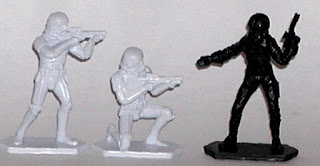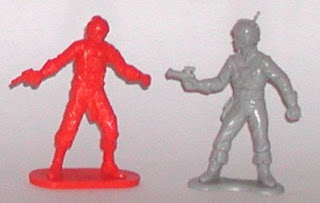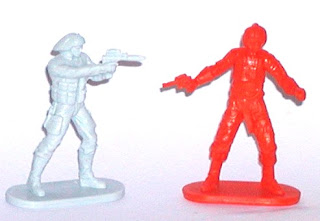Space Tank
What would a space tank be like in 1955? If energy weapons were unavailable, how might it work? We cam imagine that in low gravity, the recoil of the main gun would rock the tank ferociously. I am reminded of stories crewmen told of the old M551 Sheridan Light Tank. Its 152mm gun was great for firing the Shillelagh missile. Using the conventional rounds was another matter. It rocked the vehicle and knocked out the missile launcher’s electronics. The main gun of a tank firing a 76mm gun or larger would likely do the same or worse in low gravity.
The big problem is having an engine large enough to power the tank. We have already discussed the problem of engines, fuel and the need for oxygen. The tank would require an electric motor and a very large battery. That meant it would have to be relatively light. Vehicles the size of the Patton series (M46, M47, M48) then in use would be too heavy both to transport and to power.

Solutions existed at the time for the gun and the tank’s size. The recoilless rifle and rocket launcher were both viable weapons which had little recoil. The problems were that they had a back blast and that the shells would have to carry their own oxygen if used in a vacuum or a low-oxygen atmosphere. One of the weapons of the time combined a one-man tank with six recoilless rocket launchers mounted on the outside of the hull. The Ontos was used by the Marine Corp in Vietnam as a type of mobile direct-fire artillery. Such a vehicle was light enough that it could be battery-powered with 1950s technology. Of course, it would require significant alteration.

Another light vehicle tested by the Army could have been used. The experimental T92 light tank could be adapted to carry a recoilless weapon on top. Many light tanks could be fitted with external missiles the size of the Nike, Hawk and Little John rockets. One successful type of mounting was for small rockets. The American Calliope and Soviet Katyusha could be fitted to light vehicles. Each fired a battery of small rockets.
For the recoilless rifle and rocket launcher to be recoilless, the backblast would have to be directed outside the vehicle. There would also have to be some space between the back of the vehicle and another object like a wall or cliff. There is always a give and take with weapons systems. For the ability to fire without recoil, the backblast is a problem
Reloading can be difficult. Perhaps an automatic system would be made to slide the tube forward, bringing the back end into the crew compartment for reloading. The Swedish S tank had its breech in back, outside the vehicle. Someone would have to go outside to reload. The Ontos also had to be loaded from outside. That is not very convenient in the midst of a battle!
A vehicle would have enough room to make a recoil-absorbing buffer for light automatic weapons. A light machine gun could be used with a recoil buffer.
Among good toy tanks to convert into retro vehicles are the old MPC snap together toys. The four that are easiest to get are the tank destroyer (loosely based on the T92), open carrier with 106mm gun based on the Weasel, and an open-back Armored Personnel Carrier. These could easily be converted to retro space combat vehicles. Indeed, they can also be made into futuristic ones.
MPC also had a heavy carrier track and an open-backed track. These are harder to find, but are easily made into model space vehicles.
Marx made several tracked space vehicles for its Operation Moonbase playsets. These included a tracked wrecker, tracked vehicle with water or fuel tanks, and a vehicle with plow. All had hooks to pull a trailer and giant wheels. These wheels were supposed to be a way to transport liquids. There was also an eight-wheeled vehicle that looked like a large armored car. Marx’s vehicles were mostly one-piece castings with snap-on wheels underneath and perhaps one or two snap-on parts.
The Hamilton’s invaders sets had an odd “tank” and armored car with clear dome cockpits. The tank was more like an assault gun.
Projectile weapons in space
Projectiles such as bullets and heavier rounds work according to the laws of physics. On Earth with its gravity and atmosphere, the path of a shell is affected by velocity, gravity and windage. Windage is the flow of air that may push a round off course. Higher velocity can minimize the affect of windage.
Three things will stop a round: gravity, air resistance and an object. Velocity can resist all of them, to a point. As the round loses velocity, gravity will exert more force until it pulls it to the ground. The only exception is if the round hits an object solid enough to stop it. Air resistance and objects cause the round to lose velocity. Light objects slow it down more than air. Heavier objects can slow or stop it. Gravity itself will pull a projectile down eventually.
A low atmosphere means less air resistance, so the projectile travels further. The same goes for low gravity. A vacuum offers no resistance. The projectile will proceed unless it hits an object or gravity gets it. With enough velocity, it can travel over the curve of a planet to escape gravity, at least theoretically. On the other hand, denser atmosphere and stronger gravity will slow a bullet faster then Earth’s normal atmosphere.
Theoretically, a pellet fired in deep space could travel at its original velocity indefinitely. The reality is that it would be affected by solar winds, cosmic rays, and the minuscule gravity from very distant celestial objects. A bullet would travel a very long distance, at least thousands of miles, before various cosmic forces slowed it significantly. It may even be able to go millions of miles, like the Voyager space mission.
For the soldier fighting in a low atmosphere, low gravity situation, it means that he can shoot further. Of course, he will have to learn to compensate his aim for the new conditions. At normal combat ranges, he will be more vulnerable. Projectiles will be coming at him faster and harder than usual. In some cases, a 9mm pistol fired in low gravity and low atmosphere could have the range and impact of a 30.06 rifle on Earth.
Machine guns would likely need a large recoil buffer for low gravity. While such a thing could easily be added to a vehicle, it might be bulky and awkward for infantry using light machine guns like the Browning .30 caliber and the M60. The buffer might have to be carried separately from the weapon. It would be put on while setting up the weapon.
Grenades, like ammunition, would have to carry their own oxygen for use in low or no atmosphere conditions. A special explosive would be needed that yielded a high blast for very little oxygen. Concussion and fragmentation grenades might not have the same blast power as their conventional counterparts used in atmosphere. Then again, in a low or no atmosphere with low gravity, fragments would not meet resistance from air. The blast effect would be less than a normal grenade, but the fragmentation may be the same or even greater without resistance of air and gravity.
Thermite grenades would require an air supply. They might even be issued in two parts: a thermite can and an oxygen tank of the same size. Incendiary grenades would have little impact in low atmosphere or vacuum environments. Fire needs oxygen, and the kind of fire sets by incendiaries would need a lot of it.
Explosive warheads on rockets, missiles and other ordnance would need enough air to ignite. An oxygen supply might be built into an air-tight warhead. Again, science would have to develop an explosive that needed less air to do its work.
Whose Op Is It Anyway?
The norm is that the branch of service who first develops or discovers something is the one who owns it. Secret German technology from World War II would have been the province of the Army. The Navy would be the one turning up Japanese secret technology, since they operated across the Pacific. That is, except for operations in New Guinea and the Phillipines. Those were Army operations.
Our secret technology would have been found by the Army. That would have invoked Army Intelligence and the Office of Strategic Services. Because of its expertise in flying ,the Army Air Corps would play a dominant role in the future of the technology. I believe the whole operation would be assumed by the Air Force when it was formed from the Army in 1947.
Operating crews for the new technology would be Air Force personnel. Security would be provided by the Air Police. The Air Force has few personnel trained for sustained ground combat. These include liasons from the Strategic Air Command who travel with Army combat operations. They direct air support, especially bombers. The other are the Air Commandos, an elite unit trained for rescuing downed pilots under fire. Normally, air bases are distant enough that any ground combat will be handled by the Army.
For forays with the space technology, the Air Force will have ways to consolidate successful landings. They would create their own landing force that would include explorers, security personnel, engineers to build temporary structures etc. As combat troops for on-planet situations, they have options. They may create special armed landing parties, somewhat similar to the traditional Naval use of Marines. They may also develop larger ground formations or they may transport Army personnel for the purpose. The problem is one of purpose. The Air Force is supposed to fly. Ground operations are the work of the Army.
Either way, ground troops would need specialized training and would probably have to go through a screening process.
Would NASA or something like it emerge as a space program? Might the space operations eventually become a separate branch? Might this branch handle non-combat exploration, evoking the military only when needed? We have seen the evolution of NASA away from the Air Force to become its own civilian government agency. Many of its space crewmen are from Air Force and Navy Aviation. A specific branch for space travel makes sense.
Though space travel might be available, it would not change the status of things here on Earth all that much. There would still be tensions between nations. The military would be needed to protect the country. Just as NASA has not caused the end of conflicts here, so a Space 1955 situation would not end it in an alternate reality. The Air Force would be committed to national defense. Creating a separate branch focusing strictly on space would allow the Air Force to stick to its mission. nonetheless, the Air Force would be the guiding military branch to handle space travel in the early years of the program. When the split would be made is hard to decide. Space still might be strictly Air Force in 1955. Then again, it may already be transitioning into another arm of the government, in the alternate history scenario.
*****
Sergeant Horner leaned back in his chair, taking a sip of beer. He looked at the fellows at his table, grinned, and finished his tale,”
“Now, you know how dusty it is out at the G5 sector on the big red rock. We were holding off at least a squad of Bemmies out there. Lousy shots. Those big buggy eyes don’t help them aim any better...”
The other soldiers guffawed knowingly. Almost everyone sitting in that NCO club knew the Bemmies’ reputation for poor marksmanship.
“Okay, so we just about scattered them when my arm shakes and I hear a crack. The damn bug-eyes got a lucky shot and hit my M9's stock. Blasted the air reservoir. I was about to crawl over and grab the side-arm from the kit box when three of them rushed me. They love the hand-to-hand fight.”
The other men nodded. It was a known fact that the Bemmies liked to brawl rather than shoot.
“I dropped what was left of the rifle. Those buggy bums thought they had me, but I gave them a surprise that they never recovered from. I snatched up my entrenching tool and let them have it. Wham! Wham! Wham! Shattered their face plates and let that “healthy” Martian atmosphere do the rest. Ya gotta love that tool. Best thing to come out of the last World War,” Horner said.





















































